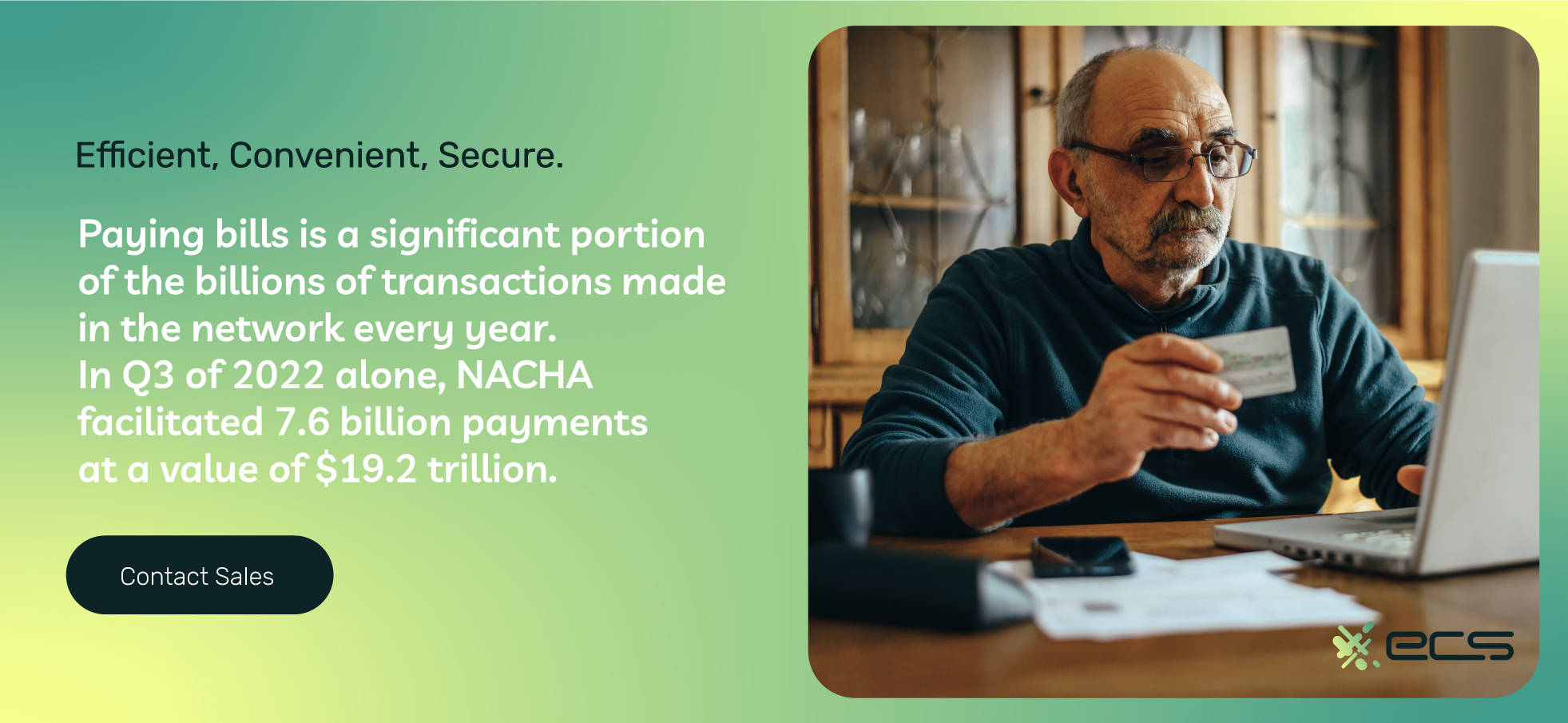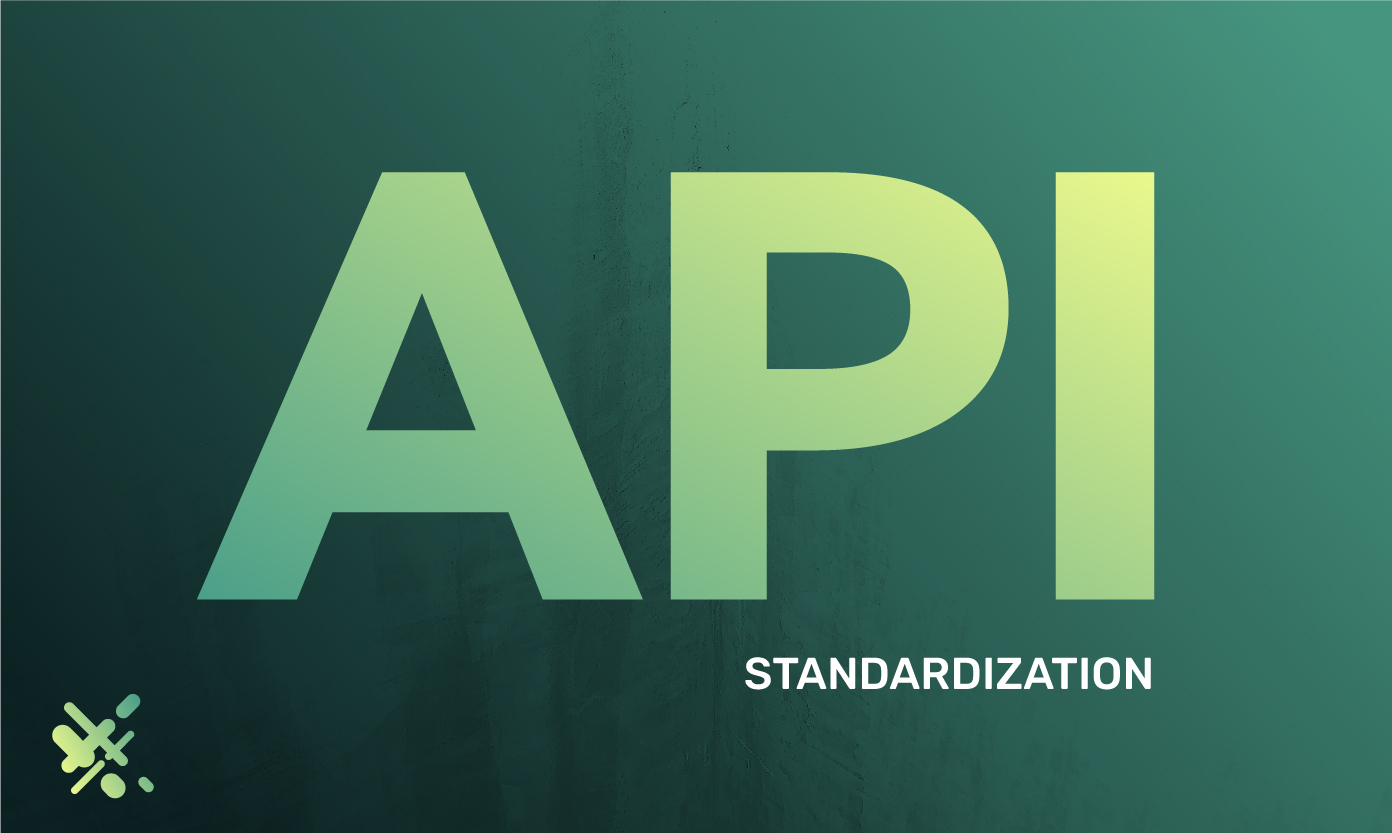In today’s continually evolving electronic payment ecosystem, NACHA API standardization is a vital cornerstone. This underlying framework plays a pivotal role in making seamless electronic transactions possible.
As a merchant, you’re very aware that accepting electronic payments is not just a matter of convenience for both you and your customers. It’s a crucial aspect of your business’s success. It’s what enables you to cater to the diverse payment preferences of your customers. Digital payments ensure a seamless and hassle-free checkout process.
However, this ecosystem is far from simple, with various participants, from the point of sale to financial institutions. Each operates with its own hardware and software. It’s in this intricate web that Application Programming Interfaces (APIs) come into play. APIs act as the bridge that connects these separate components, ensure effective communication, and make seamless electronic payments possible.
In this article, we’ll dive into the pivotal role of APIs in your business. We will explore how APIs enhance customer checkout experiences, increase security, and ensure regulatory compliance. We will also take a closer look at the developments in online payments, led by NACHA API standardization, and why these advancements matter for your business.
What is an API?
An API (Application Programming Interface) facilitates seamless electronic credit or debit card payments for businesses. To put it in simple terms, for non-programmers, APIs help the different components involved in electronic payment processing talk to each other.
There are a lot of different participants involved in electronic payment systems, from the point of sale to the clearing house to the financial institution that services merchant bank accounts. These various participants in the payment ecosystem will have different hardware and software to facilitate the process. APIs serve to integrate these components into the seamless whole of a payment experience.
Here are a few other ways that APIs assist the payment industry in addition to facilitating credit card payments and ACH transfers:
- Refunds
- Instant settlements
- Integration of local and global payment options
- Order tracking to settle real-time payments


APIs Facilitate a Smoother Customer Checkout Experience
APIs can facilitate a seamless customer checkout experience by allowing merchants to offer several different payment options for their customers. Most consumers have one preferred payment method. In fact, 42% of polled consumers said they would not go through with a transaction if their favorite payment method wasn’t available.
Around 82% of consumers use credit and debit, 79% are confident about using PayPal, and 44% are comfortable with payments on electronics such as mobile or digital wallets like those provided by Apple and Android. Although there are 450 different significant payment options around the world, some are more well-known than others.
To increase cash flow, merchants should conduct some market research. This research will help to determine which payment methods are most popular among their customer base. Once they have deduced, they should include them in their payment options. To accept payments of differing types, merchants will require specific API integrations.
APIs Facilitate a More Secure Checkout Process
A payment processor API can also facilitate improved security with fraud risk management. One way an API can promote this is by tokenizing credit card information. Tokenization involves replacing cardholder data (CHD) and payment information with one or more unrelated symbols called tokens. An algorithm generates tokens at random.
Deciphering the meaning of the token is impossible without a key. Tokens are randomly generated. Therefore, a fraudster cannot leverage the token to find out more about the online payment method used by your customer.
Tokenization is also helpful because the tokens can be stored for future transactions, improving the payment experience for return customers.
APIs Facilitate Increased Regulatory Compliance
An API, especially one provided by electronic payment services, can help make sure your business maintains compliance with the latest rules and regulations. Examples of this include best practices around implementing surcharges. For instance, some payment network services require merchants to include surcharges in their batch reports. This step might require additional accounting integrations.
As the Payment Card Interchange Fee Settlement is still unfolding in the court system, there are recent compliance changes and perhaps still changes to come, which an API can facilitate on the ground level.
Accounting Standards Codification 606 (ASC 606) is another compliance issue that eliminates accounting issues between industries. It is also meant to create more transparency in financial reporting. This issue has particular relevance in the subscription industry with its recurring payments—because revenue is not realized all at once but in stages.
There Is an Increased Demand for Payment APIs
From the merchant end, APIs may as well be synonymous with a payment processor or payment gateway. Both of which are essential for running a successful business. “Cash is King” has long been an adage among merchants. However, recent trends have shifted the bulk of payments to card and mobile transactions.
The COVID-19 pandemic accelerated this trend by forcing many consumers to shop online. As a result, there was increased growth in the payment gateway industry. The payment gateway market is estimated to have a $22.09 billion market value, with an estimated CAGR of 22% between 2022 and 2030.
This has led to a flurry of partnerships between companies like PayPal and WooCommerce. These partnerships create a more streamlined payment processing ecosystem regarding rules and standards.
The most popular APIs include (the aforementioned) PayPal, Stripe, Square, and AmazonPay. However, many merchants will find it more beneficial to work with a smaller company. Most can craft a better pricing point and offer more attentive service.
Can I Build My Own API For My Business?
A merchant or financial institution does not need to rely on a third party to provide an API. It is possible to hire a developer or programmer to create an API from scratch. This can be particularly relevant for:
- big merchants who have a high volume of transactions
- rapidly growing payment providers that need a more advanced or nuanced payment processing system
- IT firms that would like to expand their list of services by offering payment services
- acquiring banks that need to improve their front-end, customer-facing payment solutions
Building an API from scratch has its costs, however. A relatively simple API may cost anywhere from $2,600 to $7,799, while other estimates suggest an average of $20,000. Moreover, there will be periodic costs associated with servicing and updating the API.
These costs may apply to both functionality and maintaining compliance. For these reasons, many small to midsize businesses wisely choose to pay for a third-party payment gateway.
Are APIs Used Outside of Payment Processing For Businesses?
Yes, businesses use APIs extensively outside of payment processing in various industries and business applications. As mentioned previously, APIs serve as the bridge that connects different software systems and enables them to communicate and work together efficiently.
However, these systems do not always have to be systems within the payment process. These systems can be any tool that enhances a business’s operations.
In essence, APIs play a critical role in streamlining business operations, which enhances customer experiences. APIs empower businesses across various industries to connect different technologies and adapt to innovation, which makes for more efficient processes and more accessible data.
To dig a little deeper, below are some common areas where businesses in any industry utilize APIs to achieve their goals more effortlessly.

Social Media Integration
APIs enable businesses to connect their websites or applications with commonly used social media platforms such as Instagram, Facebook, Twitter, Pinterest, and even Google. They can also facilitate share button integrations and display social updates on websites in real-time. APIs also allow for features like logging into a company’s website through a user’s social media account login.
Marketing and Email Campaign Automation
APIs facilitate the integration of marketing automation tools such as CRM systems, analytics, campaign automation, and easy subscriber list management. All of which streamlines the entire marketing process.
Additionally, real-time analytics APIs provide valuable data on campaign performance, which helps businesses to optimize their email marketing strategies. Businesses can use these reports to effectively target leads and even current customers.
The data empowers businesses to acutely refine their strategies. Strategically created campaigns can be custom-tailored for specific customer segments with content personalization and precise targeting based on audience behavior and engagement.
Customer Relationship Management (CRM)
API integration with customer relationship management systems (CRMs) centralizes and creates easy access to customer data. Businesses can seamlessly integrate customer information, lead generation, and contact management tools with marketing platforms and sales software.
E-commerce & Shipping Management
E-commerce businesses leverage APIs for inventory management and order tracking. Inventory management APIs maintain accurate inventory levels and product availability, which helps to prevent overselling or overstock. Order APIs help businesses provide shipping labels and delivery time estimation to their customers, and customers can conveniently monitor the real-time status of their shipments.
Content Management Systems (CMS)
CMS platforms provide APIs that enable businesses to create, publish, manage, update, and integrate content from external systems. Content management system APIs show real-time display of content on websites.
Cloud Services
Cloud service providers offer APIs that empower businesses to manage storage and databases in “the cloud .”Businesses leverage these APIs to create, update, automate, and delete cloud resources.
Search and SEO Optimization
APIs help businesses to integrate search features, access search engine data, track rankings for keywords online, monitor their website’s performance, and gain insights for enhanced optimization.
Human Resources
HR software can provide APIs to integrate comprehensive tools and tasks such as job board maintenance, employee recruiting, new hire onboarding, staff management, background check services, and payroll systems.
Ticketing and Customer Support
APIs can connect businesses to ticketing platforms for information, purchases, and even customer support. This integration supports real-time issue resolution within online systems.
Financial Services
APIs empower the financial sector with efficiency and precision with access to account data, transaction histories, and account balances. Trading platforms can even leverage APIs to monitor real-time market data, manage investment portfolios, and execute trades.
Booking Travel Arrangements
Travel agencies and booking websites integrate APIs from hospitality services, including airlines, hotels, car rental facilities, and excursion services. These APIs enable customers to check availabilities and prices, make reservations, and access up-to-date travel information.
Secure Medical Record Access
Healthcare practices use APIs for secure data exchange and transfer, enabling patient data integration with electronic health records (EHR) systems. Patients and providers can securely access medical records, appointment information, and scheduling services online.

Education
Educational institutions use APIs to access and manage student information, course resources, and online learning platforms. This API integration streamlines the educational experience for both students and faculty.
Public and Civic Services
APIs, through third-party applications, offer publicly accessible services such as weather updates, traffic information, and various public records.
Data Integration
APIs can help businesses synchronize data across their systems to ensure that all data is accurate across the organization. This integration can save businesses money and time and eliminate the need to manually enter data into various systems.
Accurate and consistent information across all systems within a business also improves the customer experience with a more seamless experience regardless of the channel.
IoT (Internet of Things)
APIs help in the connection of IoT (Internet of Things) devices. “Internet of things” are devices with technologies and software that connect to other devices and exchange data with other systems over the Internet or online networks. IoT APIs empower businesses to gather data, perform monitoring remotely, and implement seamless automation.
For example, an API connects a smart home thermostat to a phone app so that the user can control their thermostat from their phone even while they are away.
Okay, and now back to business payment processing and API Standardization.
What Is the Difference Between Credit and Debit Payments Versus ACH Transactions?
A payment processor will partner with a card network (such as Visa, Mastercard, Discover, or Amex) to facilitate credit card and debit card payments. The transaction process has several steps, such as verifying the availability of funds within the customer’s account and contacting the merchant’s financial institution (the acquirer) to eventually settle a payment.
The card networks act as a clearing house for the process, a link between one party and the other. Having the money pass through the clearing house makes sure that both parties will honor their commitment—in this case, the customer’s bank and your merchant bank.
The ACH Network Does Not Instantly Verify Funds
The ACH network is a bit different from credit and debit networks.
One difference is that ACH payments do not necessarily verify the presence of funds in the paying account (unless a particular API is used for that). That’s why something like a recurring payment can tap into a checking account and put it into the red. At the same time, a credit card or debit card will just be declined at the point of sale if there is not enough cash or credit on the account.
The ACH Network Takes Longer to Settle Funds
Another difference is in speed: credit card processing can often be faster and, in some cases, nearly instantaneous. ACH processing, on the other hand, can generally take 3-5 days before the funds settle. The tradeoff is that ACH processing has much lower fees, usually costing $0.25 to $0.75 per transaction.
The ACH Network Clearing House Differs From Credit and Debit Network Clearing
Yet another difference is in terms of the backend operations and the clearinghouse. In card networks, Visa, Mastercard, Discover, and Amex are clearinghouses. In the ACH network, the clearinghouse is the Federal Reserve Bank.
The banks send out payments or payment requests in batches throughout the day. The ACH network only performs tasks on business days. Meaning they do not process payments on weekends or holidays.
Many merchants are okay with waiting an extra day or two in return for much lower fees. Moreover, NACHA has been actively developing a same-day ACH process and is already processing more than 600 million per year.
Of course, ACH payment is mainly beneficial for subscription services. For one-off retail purchases, either online or in person, credit and debit are much more convenient consumer options. Nobody wants to pull a paper check out of their wallet, hunt for one at home, or even log on to their banking app to find account numbers. But especially for eCommerce merchants and subscription-based merchants, ACH is an important option to provide.

What is NACHA?
Unlike what it sounds like, NACHA, or the National Automated Clearing House Association, is not something that goes well with melted cheese and jalapeños. NACHA is, in fact, the organization tasked with governing the ACH network. It does not govern the credit or debit networks. Those have separate regulations and overseeing entities.
This association is not a government organization (contrary to what you may think). Nor is it a for-profit business. Rather, NACHA is a 501(c)(6) not-for-profit association incorporated in 1974. Today, more than 9,000 financial institutions participate in NACHA, including banks, credit unions, and other similar financial institutions.
Some of the board leadership includes CEOs and other executives from J.P. Morgan Chase & Co., Fifth Third Bank, Bank of America, and the Federal Reserve. NACHA is responsible for creating the rules and standards that guide the payment industry, particularly in direct deposits and direct payments.
If you’re wondering what exactly that has to do with a business that takes credit cards and cash, it probably relates to your payroll unless you’re still issuing paper checks (and if you are, you shouldn’t be because each check can cost up to $20 for all of the HR work behind it).
You may also have vendors and suppliers who are debiting your checking account regularly through the ACH network. Lastly, as mentioned earlier, offering a variety of payment methods for clients and customers is vital to creating a smooth payment experience.
Some customers may prefer to pay with an eCheck or ACH payment, especially for automated payments like subscription services or utility bills. Paying bills is a significant portion of the billions of transactions made in the network every year. In Q3 of 2022 alone, NACHA facilitated 7.6 billion payments at a value of $19.2 trillion.
Explaining the NACHA API Standardization
So, given the function of NACHA operating rules to streamline the payments industry (at least the bank-to-bank aspect of it), it’s no surprise to see that NACHA is interested in API standardization. The rapidity of payments and security are two driving factors behind the push for a uniform set of API policies and rules.
A group of industry thought leaders in the financial services sector has been collaborating actively with NACHA’s board to craft a more uniform process that can prevent data breaches and payment fraud—a critical development given the unfolding complexity of the global payment ecosystem and its various fiat and cryptocurrencies.
To this end, NACHA has created Afinis Interoperability Standards, a sub-organization that will generate financial service standards across the different operating environments in the ACH network. Programmers, payment processors, and even merchants can register their API to receive automatic notifications about updates to the standards.
There is also a programmer sandbox that developers can use to test out their API and see if it meets the NACHA standards. There are forums for business owners, financial institutions, and developers to engage in discussion or collaborate.
Additionally, there are links to approved APIs for various functions, such as real-time account validation, payment initiation, and authorization. Others allow billers to route billing information anywhere in the network or provide corporate transaction history. You can explore these APIs on the NACHA website along with future APIs in development.
Does NACHA API Standardization Matter?
NACH API standardization most certainly does matter. Standardization will provide more significant measures of security, speed, and improved customer experience. Remember that there are 450 different payment methods around the world and dozens (if not hundreds) of third-party API payment gateways, not to mention thousands (if not millions) of APIs that are internally company-specific.
An analogy that helps describe the situation is to picture an English speaker trying to communicate with someone who only speaks French—but the translator doesn’t speak French…just Spanish. So another translator is brought in who speaks Spanish and French, creating a comical game of telephone that might remind you of an episode of I Love Lucy.
Ultimately, NACHA API Standardization will facilitate the translation process between hardware and software of the payment ecosystem, creating a more secure, faster, and more straightforward process for payments made in the ACH network.
Frequently Asked Questions About NACHA API Standardization For Businesses
API stands for Application Programming Interface. It facilitates seamless electronic credit or debit card payments for businesses. It allows the different components involved in the electronic transaction processes to communicate effectively with one another.
APIs are crucial in integrating the various hardware and software used within the payments ecosystem. ECS Payments offers integrated payment APIs for a seamless payment experience.
Customers often have their preferred method of payment. APIs allow merchants to offer multiple digital payment options, facilitating a smoother customer checkout experience. ECS Payments can easily integrate all your business tools and software with your API for convenient point-of-sale and business management.
APIs enhance security by encrypting and tokenizing sensitive payment information. Tokenization replaces cardholder data with randomly generated symbols or “tokens,” which cannot be deciphered without a key. This reduces the risk of data breaches and potential fraud.
Additionally, tokenized card information can be stored for future transactions, improving the payment experience for returning customers.
ECS risk department ensures monitoring for suspicious activity, which extends your fraud detection measures alongside our secure online payment systems.
An API, especially one provided by a payment services company such as ECS Payments, can help a business maintain compliance with network rules and regulations. This includes practices such as implementing surcharges and any other changes in the payment industry’s regulations.
NACHA is the acronym for the National Automated Clearing House Association. It is the organization that governs the ACH network. NACHA is not a government organization or a for-profit business. It is a 501(c)(6) not-for-profit association with more than 9,000 participating financial institutions, including credit unions, banks, and payment processors such as ECS Payments.
NACHA’s leadership includes high-level executives from leading financial institutions, including J.P. Morgan Chase & Co., Fifth Third Bank, Bank of America, and the Federal Reserve. NACHA creates the rules and regulations that guide the payments industry, specifically with direct deposits and direct payments, or ACH transactions.
NACHA API Standardization refers to the effort to create uniform rules for merchant APIs in payment processing, particularly with the ACH network. This API standardization is essential to ensure security, speed, and a better customer experience. It connects different entities, software, and devices for clear communication.
